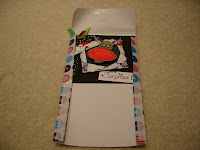 I thought I would post some pictures of some cards I made a couple of years ago, but as they primarily use papers for the technique, I thought they would be useful. Some of the cards do have a little stamping on them but the cards could easily be recreated without.
I thought I would post some pictures of some cards I made a couple of years ago, but as they primarily use papers for the technique, I thought they would be useful. Some of the cards do have a little stamping on them but the cards could easily be recreated without. Essentially the technique involves non-colourfast papers. By applying water to the paper the dye can be transferred to another card. Tissue paper and crepe paper are best for this technique but it could be tried with other papers
Essentially the technique involves non-colourfast papers. By applying water to the paper the dye can be transferred to another card. Tissue paper and crepe paper are best for this technique but it could be tried with other papers Creating backgrounds is the easiest method to try first. Wet a fairly sturdy piece of cardstock with a paint brush and water, then lay strips of tissue to create scenery or try using scrunched up scraps and overlaying and dabbing to create different effects. It's worth practicing on a scrap of card first to judge how much water is needed and how intense the colour is. Both techniques require enough moisture to make the dye bleed out, but don't forget, when paper or card is damp it warps, so its worth allowing a bit of time for the dyed base card to be allowed to dry, then flattened under some heavy books before you continue to work on it
Creating backgrounds is the easiest method to try first. Wet a fairly sturdy piece of cardstock with a paint brush and water, then lay strips of tissue to create scenery or try using scrunched up scraps and overlaying and dabbing to create different effects. It's worth practicing on a scrap of card first to judge how much water is needed and how intense the colour is. Both techniques require enough moisture to make the dye bleed out, but don't forget, when paper or card is damp it warps, so its worth allowing a bit of time for the dyed base card to be allowed to dry, then flattened under some heavy books before you continue to work on itMask off areas or work over a stencil to create dyed areas

This precious scrapbook page is of my husband (much younger!!!)and my daughter Gina, on the very first Red Nose Day. Gina was so excited , but the trouble was her own nose was a bit too small to keep the plastic one on, so she spent the whole time with it balanced on top of her nose and her head tipped back. She loved red nose day and collected a nose every year until the year she died....she thought they would become collectors items and said when she was old she would auction them off for charity...perhaps one day I will be able to grant her wish...I know they are still amongst her treasures.
So don't forget when unwrapping your pressies on Christmas Day, grab any coloured tissue, doesn't matter if it's crumpled..... and fingers crossed it's not colour-fast!!












 TIP: MAKE PLEAT ENVELOPES FOR 3D DECOUPAGE CARDS.
TIP: MAKE PLEAT ENVELOPES FOR 3D DECOUPAGE CARDS.











